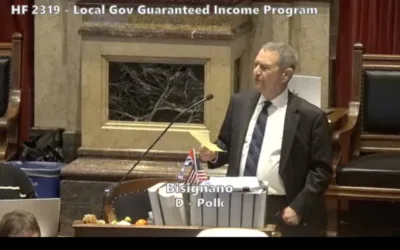
2019 was a long year for Iowa farmers.
It’s hard to keep up with everything that happens in a news cycle. Multiply that by 365 days of Donald Trump as president, and you end up with more than one could possibly stay up to date on.
But for Midwest farmers, 2019 was particularly hectic. From floods and disaster relief to farm foreclosures, biofuels tensions to shuttering ethanol plants, and the trade war, there was no shortage of heartbreak.
Ethanol news, and the tension between biofuels producers, commodity farmers and the fossil fuel industry, was reason for a lot of headlines for the year. But how much really happened in 2019? The short answer is, not actually a lot.
However, because of a constant stream of big promises made along the way by President Trump, a whole lot of nothing felt like constant disappointment.
Let’s take a look at the year in a chronological fashion and see how we ended up here.
[inline-ad id=”0″]
March
Though trade war tensions have been ongoing for a while, March is when tempers really started to flare in terms of biofuels.
In March, the EPA granted additional Small Refinery Exemptions (SREs) for 2016-2017. This was where contrast started to show between the Obama and Trump administrations.
During the last three years of the Obama administration, they granted 8 (2013), 8 (2014) and 9 (2015), all of which were around half of those applied for.
After granting these additional waivers in March, Trump’s first year in office saw 19 of 20 waivers granted. Once final numbers were set for 2017, it was 35 of 37 exemptions accepted.
The Renewable Fuel Standard (RFS) was officially being undercut as a law.
April/May
Then the pushback started. After seeing the final numbers for exemptions granted, and gallons of ethanol blocked from being blended into the nation’s fuel supply, concerns started to grow in Iowa, and across the Midwest.
April and May were slower months in terms of news. Mostly, there were considerations in the ethanol industry about how to push back, and there was an effort to understand how the refinery exemptions hurt farmers.
[inline-ad id=”1″]
June
To kick off the summer, Trump came to Iowa to fundraise on the heels of an announcement for the year-round sales of E-15. This did not go well, as Trump received heavy pushback from farmers around the state, as well as statewide Democratic leadership, for coming out to talk about what was coined an “empty deliverable.”
After the trip went sour, Trump returned to D.C. and had a closed-door meeting with Andrew Wheeler, head of the EPA, and reportedly directed the agency to reconsider their approach to SREs.
When news of his unease was leaked in Washington, farmers hoped real action would happen to restore ethanol gallons back into the nation’s fuel supply.
July
Fresh off the news that the EPA would review its SRE position, things seemed to be looking up. However, as the next six months would show, little would come from it.
In the middle of the month, the EPA released its expected Renewable Volume Obligation (RVO) numbers for 2020, which showed the slightest increase in blending of ethanol. While these numbers were reason for hesitation, there was also good reason to expect them to not even be fulfilled.
Democratic leadership in Iowa again called out the Trump Administration and EPA for a “bait-and-switch” and waited to see if any real deliverable would be offered. Around this time, we also saw ethanol plants across the Midwest start to close. Even as the EPA continued to argue that the SREs weren’t causing any market damage, plants were shutting down due to a “supply-demand imbalance.”
Yet, at the end of the month, the EPA again said it would continue down the same road with SREs, and held its position that the waivers were not damaging demand.
[inline-ad id=”2″]
August
By August, the EPA had already defended its position multiple times, and tried to make the case that SREs weren’t hurting demand, even as plants continued to close. This led to anger among farmers, who had, by now, been pleading for months for some corrective measure.
Even Sens. Chuck Grassley and Joni Ernst began feeling the pressure, getting criticized at their own town halls. This led them to publicly plead with Trump, telling him that he was losing more and more Iowa support by the minute.
Yet, in August, even more SREs were granted, and farmers told Trump this was the “last straw.” By now, Democratic candidates for the presidential nomination were piling on Trump, recognizing an opportunity to make the case to Iowans that they could help recover and protect the renewable fuel industry.
By the end of the month, Trump came out and promised a “giant package” that would make farmers happy on the ethanol front.
[inline-ad id=”3″]
September
To start September, the California Air Resource Board (CARB) came to Iowa to talk to corn farmers about their conservation practices, tour ethanol facilities, and talk to biofuel groups about pursuing carbon-neutral, or carbon-negative, farming and ethanol production. The two-day trip, and set of meetings, set the potential path for a relationship between California and Midwest ethanol.
Throughout the month, ethanol facilities continued to close, or put their operations on hold, and tensions continued to grow. This is also when the impeachment inquiry was formally launched in the U.S. House.
With an impeachment inquiry officially underway, Trump looked for some type of a victory. This led him to consider upping the trade dispute with China amidst the ethanol debacle, grabbing at straws for some way to regain rural support.
October
October was the month of the three-year rolling average. The EPA announced a ‘new’ deal early in the month would ‘boost’ ethanol sales by replacing gallons lost back into the fuel supply with a rolling average of gallons exempted via SREs over the last three years.
This, too, disappointed, as the three-year average would undermine the high amounts exempted in the last year, or two years. Sen. Amy Klobuchar was in the state and called it a “vague promise” that would earn Trump no credit once people understood it.
[signup_form]
Around this time, Vice President Mike Pence made a trip out to the state on behalf of the administration. During his time, he too received harsh feedback for “disrespecting farmers” and dealing out market damage to the ethanol industry.
Then, Wheeler and Trump said they would create a plan that would accurately replace gallons lost, and they met with farm-state representatives, governors and senators. But just a week later, the EPA put the terms of their three-year rolling average plan out into the ether, and announced a comment period.
More ethanol plant closings continued to follow.
At the end of the month, there was a hearing in the House to review all that had happened up to this point. Renewable fuel leaders summed up the issue well when they said that EPA’s SREs stance was “crippling rural America.”
[inline-ad id=”4″]
November
The public-comment period that the EPA had announced in October was ongoing, set to end at the end of the month. Anticipation built for a release of a plan, but Midwest farmers and commodity groups across the U.S. resisted holding their breath.
By this point, it was clear that Trump could not be trusted for his grandiose promises he continued to make. As Aaron Lehman, president of the Iowa Farmers’ Union, put it, “this is Trump’s EPA, there’s no separating the two at this point.” As this became clear, anxiety grew over the impending announcement in December.
More than 11,700 comments were submitted to the EPA during its nearly two-month comment period.
December
Now a full three years after Trump promised to be the “most pro-ethanol administration,” the ethanol industry waited for a verdict. Farming and renewable fuel groups hoped for the best, looking for a correction, but didn’t get their hopes too high.
Finally, that verdict came. After months of back-and-forth, the EPA finalized plans to continue down the same path, granting SREs as they have done over the last three years. They did, however, also officialize their plan to use a three-year rolling over to replace some of the gallons, the same deal many objected to when it was originally announced in October. The numbers from that calculation don’t line up with actual gallons lost, instead coming closer to the number from the Department of Energy, who fought back against the SREs in the first place.
[inline-ad id=”5″]
2020
Only place to go is up, right? After nine months of fighting, promises made, deals proposed, pushed back on, taken back, re-released, the EPA will pretty much do what came to mind as their first idea.
Renewable fuels now look to be an issue on the ballot in 2020. With everything farming and fuel groups said over the last nine months, it seems hard to believe that they will all still support Trump in 2020. But hard to believe is also code for hard to accept.
We’ll see where these organizations align in 2020, but it seems clear that current Republican leadership isn’t heavily invested in keeping these plants open, or helping keep the renewable fuel industry stay afloat.
By Josh Cook
Posted 12/31/19

Iowa Republicans make outlawing gay marriage key 2024 campaign priority
Iowa Republicans have made outlawing gay marriage a key goal in their 2024 party platform. During the Iowa GOP’s 2024 state convention on Saturday,...

Department of Justice says Iowa immigration law violates US Constitution
If Iowa doesn’t suspend the enforcement of its new immigration law by May 7, the state could face a federal lawsuit, according to the Des Moines...

Rushing: Iowa State president said the quiet part out loud
I want to thank Iowa State University President Wendy Wintersteen for doing us all a favor by finally saying the quiet part out loud: all the...

Iowa sets aside almost $180 million for year two of voucher program
Iowa has committed nearly $180 million in taxpayer funds to support private school tuition in the 2024-25 school year, which is almost $50 million...

Kalbach: Immediate action needed on corporate ag pollution
Iowa agriculture has undergone substantial changes over the past 40 years. We see it all around us. Rather than crops and livestock being raised on...

VIDEO: Jochum calls Gov. Reynolds’ summer meal program a ‘hunger game’
Iowa Gov. Reynolds announced a competitive $900,000 grant program to feed Iowa children over the summer, months after she declined $29 million in...




